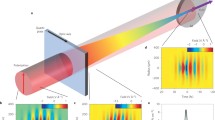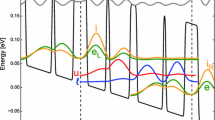Abstract
We study the transient gratings photogenerated in the picosecond regime in three families of structures, namely : - structures of thickness in the order of one micron, including quantum wells (GaAs/GaAlAs, CdTe/ CdZnTe). A transmission modulation due to the electric field has been observed. We show that, in accordance with our calculations, this modulation is screened faster than 10 ps at a fluence of a few µJ/cm2. - A structure including GalnAs/GalnAsP MQWS in a cavity. This structure shows a top diffraction efficiency of 2.5 × 10-2 at 1.55 µm for an energy of excitation in the order of 100 µJ/cm2. The diffraction efficiency exhibits several oscillations due to Fabry-Pårot effects. By introducing cavity effects in our model, we show that the diffraction efficiency is amplified by more than a factor 2 with respect to the no-cavity case. Calculations show that the diffraction efficiency may reach 6 × 10-2 around 1.625 µm, for a front mirror reflectivity of 90 %. - Structures including bulk GaAs microcavities. The risetime is lower or in the order of 1 ps while the diffraction efficiency attains 1 %, with an average power of 4 mW (i.e. an energy of 2 µJ/cm2/pulse), compatible with a commutation of packets at 80 MHz.
Résumé
Les réseaux transitoires photogénerés en régime picoseconde sont étudiés dans trois types de structures : - des structures constituées de puits quanti-ques(GaAs/GaAlAs, CdTe/CdZnTe), d’épaisseur totale de I’ordre du micromètre, et dans lesquelles le champ électrique produit une modulation de la transmission. Cette modulation disparaît en moins de 10 ps, par écran-tage du champ électrique conformément à nos calculs.- Une structure constituéede multipuits GalnAs/ GalnAsP dans une cavité; cette structure présente une efficacité de diffraction maximale de 2,5× 10-2 à 1,55 µm avec une énergie d’excitation de 100 µJ/cm2. L’efficacité de diffraction présente des oscillations dues à I’effet Fabry-Pérot. En introduisant les effets de cavité dans notre modéle, I’efficacité de diffraction est augmentée d’un facteur supérieur à 2 par rapport au cas sans cavité. Les calculs montrent que I’efficacité de diffraction peut atteindre 6 × 10-2 à 1,625 µm, avec une réflectivité de 90 % pour le miroir frontal.- Des structures à microcavités avec région centrale en GaAs. Le temps de montée est inférieur ou de I’ordre de 1 ps et I’efficacité de diffraction atteint 1 %, avec une puissance moyenne de 4 mW (i.e. une énergie de 2 µJ/cm2/impulsion), compatible avec une commutation de paquets 80 MHz.
Similar content being viewed by others
References
Smirl (A. L.), Valley (G. C), Bohnert (K. M.), Boggess (T. R). Picosecond photorefractive and free-carrier transient energy transfer in GaAs at 1 µm.IEEE J. QE (1988),24, p. 289–303.
Petrovic (M. S.), Suchocki (A.), Powell (R. C), Cantwell (G.), Aldridge (J.),. Laser-induced grating spectroscopy of cadmium telluride.J. Appl. Phys. (1989),66, p. 1359–1365.
Gouaichault (N.). Réseaux transitoires dans les semiconducteurs sous forte excitation photonique.These, INSA de Toulouse (1994).
Nolte (D. D.), Olson (D. H.), Doran (G. E.), Knox (W. H.), Glass (A. M.). Resonant photodiffractive effect in semi-insulating multiple quantum wells.J. Opt. Soc. Am. B (1990),7, pp. 2217–2225.
Pelekanos (N. T.), Haas (H.), Magnea (N.), Mariette (H.), Wasiela (A.). Room-temperature exciton absorption engineering in II-VI quantum wells.Appl. Phys. Lett. (1992),61, pp. 3154–3156.
Haas (H). Effet Stark quantique dans les puits quantiques de CdTe/CdZnTe et développement d’un dispositif photoréfractif.Thèse, Université de Grenoble 1 (1995).
Grac (R),Pugnet (M),Magnea (N.),Pautrat (J. L.). Picosecond all-optical modulation in CdTe/CdZnTe multi-quantum wells under an applied electric field.9th Conference on Semiconducting and Insulating Materials, Toulouse (1996).Proceedings IEEE (dec. 1996), pp. 119-123.
Schneider (H.), Klitzing (K.). Thermionic emission and Gaussian transport of holes in GaAs/AlGaAs multiple-quantum-well structure.Phys. Rev. B (1988),38, pp. 6160–6165.
Grac (R.). Physique de la déflexion picoseconde par réseaux photoinduits dans les semiconducteurs.Thèse, INSA de Toulouse (1996).
Kogelnik (H.). Coupled wave theory for thick hologram gratings.Bell Syst. Tech. J. (1969),48, pp. 2909–2947.
Yablonovitch (E.), Sands (T), Hwang (D. M), Schnitzer (I.), Gmitter (T. J.), Shastry (S. K.), Hill (D. S.), Fan (J. C. C). der Waals bounding of GaAs on Pd leads to a permanent, solid- phase topotaxial, metallurgical bond. Appl.Phxs. Let. (1991),24, pp. 3159–3961.
LF. Gratiet (L.),Bedki. (E.),Grac (R.),Fontaine (C),Puc.Net (M.). Subnanosecond optical deflection in Van der Waals bounded GaAIAs-GaAs MQW : effects of carrier lifetime and electric field.9th Conference on Semiconducting and Insulating Materials, Toulouse (1996).Proceedings IEEE (déc. 1996), pp. 329-333.
Le Gratiet (L.). Structures photoréfractives à base de multipuits quantiques GaAs/GaAlAs fonctionnant en transmission pour 1’adressage optique.Thèse, Universite de Toulouse (1996).
Collet (J. H.), Buhlefer (R.), White (J. O.). Enhanced diffraction of light in GaAs microcavitics.J. Opt. Soc. Am. B (1995),12, pp. 2439–2444.
Lambert (B.), Baudet (M.), Gauneau (M), Li-: Corre (A.).Lever (R.), L’Haridon (H.), Moisan (G.), Salaun (S.) Vaudry (C). Fast photorefractivc multiple quantum well working at 1.55 µm.Internation. Conf. on Semicond. Heterostructures, Montpellier (July 1995).
Haug (H.),Koch (S. W.). Quantum theory of the optical and electronic properties of semiconductors. World Scientific (1990).
Suciawara(M.), Fujii (T.), Yamazaki (S.), Nakaj1Ma (K.). Theoretical and experimental study of the optical absorption spectrum of exciton resonance in InGaAs/InP quantum wells.Phys. Rev. B (1990),42, pp. 9587–9597.
A part of this work has been presented in :Grac (R.).Pugnet (M.),Collet (J. H.),Lambert (B.),De Matos (C). L’Haridon (H.),Le Corre (A.),White (J. O.). Photodirffraction in InGaAs/InGaAsP multiquantum wells. 9th International Conference on Superlaltices, Microstrudures and Microdeviccs (ICSMM), Liège (14-19 July 1996), in Superlattices and Micro-structures (1997), in press.
BArdinal (V), Legros (R.), Fontaine (C). Precision Bragg reflectors obtained by molecular beam epitaxy underin situ tunable dynamic reflectometry control. Appl. Phys. Lett. (1995),67, pp. 3390–3392.
Yang (C. M), Mahgerefteh (D.), Garmire (E.), Chen (L.), Hu (K.), Madhukar (A). Sweep-out times of electrons and holes in InGaAs/GaAs multiple quantum well modulator.Appl. Phys. Lett. (1994), 65, pp. 995–997.
Livescu (G.), Fox (A. M.), Miller (D. A. B.), Sizer (T.), KNOX (W. H.), Cunningham (J.E.), Gossard (A. C), English (J. H.). Optical detection of resonant tunnelling of electrons in quantum wells.Semicond. Sci. Technol. (1990),5, pp. 549–556.
Feldman (J.), Goossen (K. W.), Miller (D. A. B.), Fox (A. M.), Cunningham (J. E.), Jan (W. Y.). Fast escape of photocreated carriers out of shallow quantum wells.Appl. Phys. Lett. (1991),65, p. 66–68.
Hayashi (G.), Kodama (S.), Yamaoko (Y), Takano (A.), Hirakimoto (K.), Lee (Y), Yamanishi (M.). Charge-induced self-feedback optical bistable device: switching time and spatial resolution.IEEE J. QE (1993),29, pp. 2655–2661.
Canoglu (E.), Yang (C. M.), Garmire (E.), Mahgerefteh (D.), Partovi (A.), Chiu (T. H.), Zydzik (G. J.). Carrier transport in a photorefractive multiple quantum well device.Appl. Phys. Lett. (1996),69, pp. 316–318.
Buhleier (R.), Bardinal (V.), Collet (J. H.), Fontaine (C), Hubner (M.), Kuhi. (J.). Four-wave mixing in bulk microcavities at room temperature.Appl. Phys. Lett. (1996), 69, pp. 2240–2242.
Author information
Authors and Affiliations
Additional information
This work was supported by France Télécom under the contract n° 93 IB 140.
Rights and permissions
About this article
Cite this article
Iehl, JL., Grac, R., Gratiet, L.l. et al. Picosecond photodiffraction in semiconductor multiquantum wells and microcavities. Ann. Télécommun. 52, 627–637 (1997). https://doi.org/10.1007/BF02997618
Received:
Accepted:
Issue Date:
DOI: https://doi.org/10.1007/BF02997618
Key words
- Semiconductor device
- Picosecond phenomena
- Optical diffraction
- Multiple quantum well
- Optical switching
- Packet switching
- Optical modulation
- Photoinduced effect
- Optical deflector




